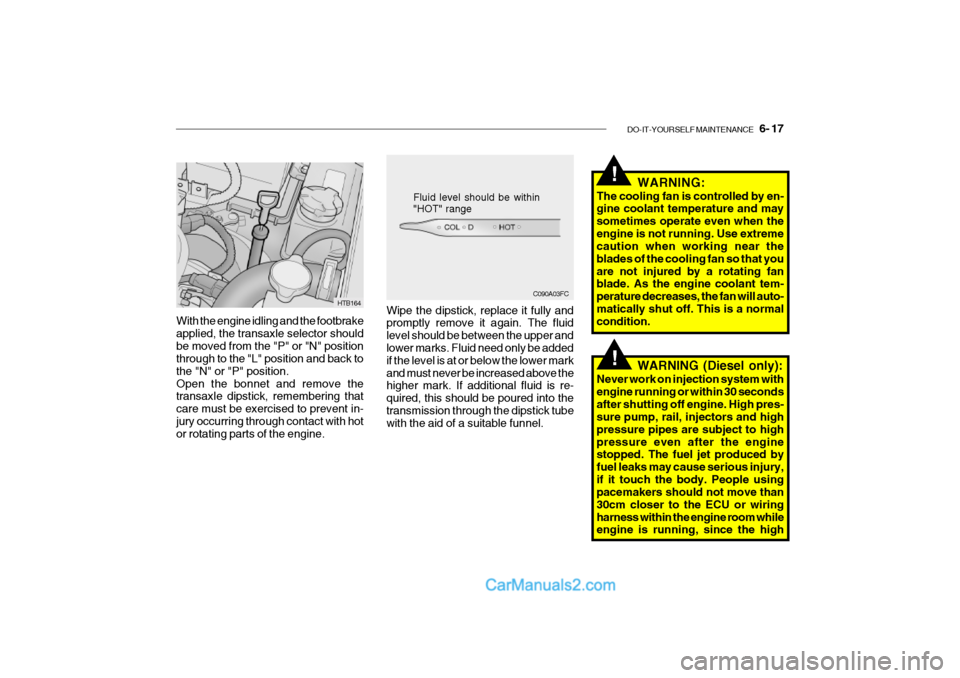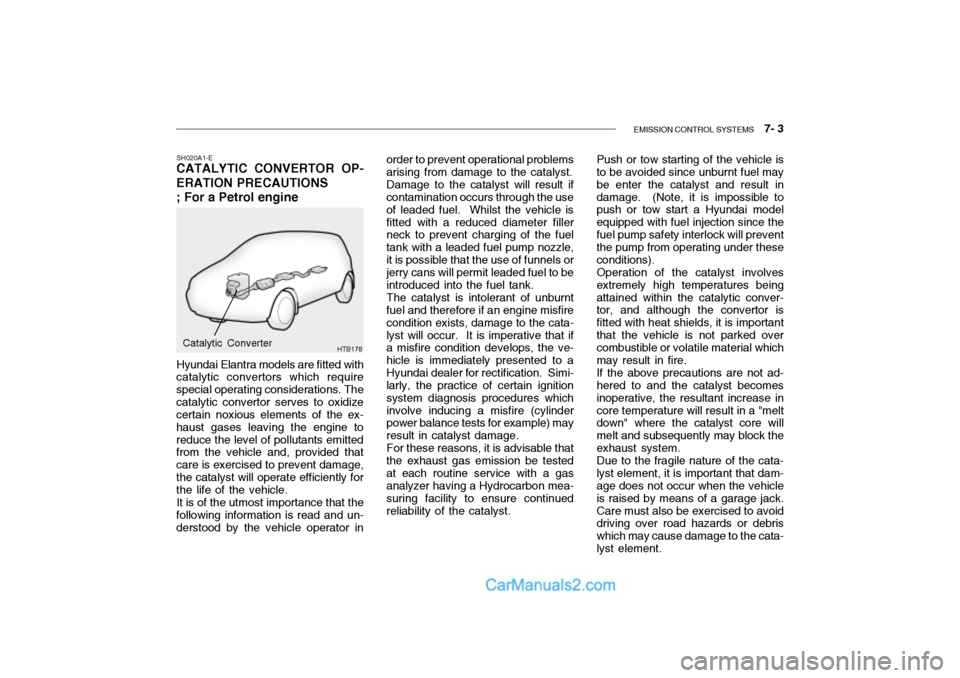2002 Hyundai Getz fuel pump
[x] Cancel search: fuel pumpPage 371 of 428

VEHICLE MAINTENANCE REQUIREMENTS 5- 7
6ZF060A1-A
EXPLANATION OF SCHEDULED MAINTENANCE ITEMS
6ZF060M1-A
o Engine oil and filter
The engine oil and filter should be changed at the intervals specified inthe maintenance schedule. If the car is being driven in severe conditions, more frequent oil and filter changesare required. 6ZF060B1-A
o Drive belts
Inspect all drive belts for evidence of cuts, cracks, excessive wear or oilsaturation and replace if necessary. Drive belts should be checked peri- odically for proper tension and ad-justed as necessary. 6ZF060C1-A
o Fuel filter
A clogged filter can limit the speed at
which the vehicle may be driven, dam- age the emission system and cause hard starting. If an excessive amountof foreign matter accumulates in the fuel tank, the filter may require re- placement more frequently.
After installing a new filter, run the
engine for several minutes, and checkfor leaks at the connections.
F060D01TB-EAT
o Fuel lines, fuel hoses and con- nections
Check the fuel lines, fuel hoses and
connections for leakage and damage. Replace any damaged or leaking parts immediately.
6ZF060E1-A o Timing belt Replace timimg belt and inspect all associated parts related for damageand deformation. Replace any dam- aged parts immediately.
!WARNING (Diesel only):
Never work on injection system with engine running or within 30 seconds after shutting off engine. High pressure pump, rail, injectorsand high pressure pipes are sub- jected to high pressure even after the engine has been switched off.The fuel jet produced by fuel leaks may cause serious injury, if it con- tacts with the body. People usingpacemakers should not move closer than 30cm to the ECU or wiring harness within the engine room with the engine running, since the high currents in the CommonRail system produce considerable magnetic fields.
Page 391 of 428

DO-IT-YOURSELF MAINTENANCE 6- 17
With the engine idling and the footbrake applied, the transaxle selector shouldbe moved from the "P" or "N" position through to the "L" position and back to the "N" or "P" position.Open the bonnet and remove the transaxle dipstick, remembering that care must be exercised to prevent in-jury occurring through contact with hot or rotating parts of the engine.
C090A03FC
Fluid level should be within "HOT" range
HTB164 Wipe the dipstick, replace it fully and promptly remove it again. The fluid level should be between the upper and lower marks. Fluid need only be added if the level is at or below the lower markand must never be increased above the higher mark. If additional fluid is re- quired, this should be poured into thetransmission through the dipstick tube with the aid of a suitable funnel. WARNING:
The cooling fan is controlled by en-gine coolant temperature and may sometimes operate even when theengine is not running. Use extreme caution when working near the blades of the cooling fan so that youare not injured by a rotating fan blade. As the engine coolant tem- perature decreases, the fan will auto-matically shut off. This is a normal condition.
!
!WARNING (Diesel only):
Never work on injection system with engine running or within 30 secondsafter shutting off engine. High pres- sure pump, rail, injectors and high pressure pipes are subject to highpressure even after the engine stopped. The fuel jet produced by fuel leaks may cause serious injury,if it touch the body. People using pacemakers should not move than 30cm closer to the ECU or wiringharness within the engine room while engine is running, since the high
Page 400 of 428

6- 26 DO-IT-YOURSELF MAINTENANCE
HTB287
SG230B1-E POWER STEERING HOSES Power steering hoses should be checked for damage, deterioration andleakage at each service.
steering fluid level is between the "MAX" and "MIN" level markings on the fluid reservoir. NOTE: Grinding noise from power steering pump may be heard immediatelyafter the engine is started in extremely
cold condition (below -4°F). If the noise stops during warm up, there isno abnormal function in the system. This is due to a power steering fluid characteristic in extremely cold con-ditions. FLUID RECOMMENDATION Only automatic transmission fluid meet- ing the specification of PSF-3 shouldbe used in the power steering system.
G300A01TB-GAT REMOVAL OF WATER FROM THE FUEL FILTER(DIESEL ENGINE) If the fuel filter warning lamp illuminates during driving, it indicates that waterhas accumulated in the fuel filter. If this occurs, remove the water as described.
SG230A1-E POWER STEERING FLUID LEVEL The power steering fluid level should be checked daily.To check the power steering fluid level, be sure the ignition is "OFF", then check to make certain that the power
HTB163
Page 408 of 428

6- 34 DO-IT-YOURSELF MAINTENANCE
G200C01TB-GAT FUSE PANEL DESCRIPTION Engine Compartment
HTB261-EPROTECTED COMPONENTS
Ignition Switch
Ignition Switch, Start Relay
Fuel pump, Alternator, ECM
Auto Fuel Cut Switch
Radiator Fan
Headlight, Defogger RelayABSECMA/CON, Fuel PumpInjectorA/Conditioner
HornABSABS
Blower, Blower Motor
Power Window
Electronic power steering AlternatorSpare Fuse Spare FuseSpare Fuse
FUSE RATING
30A30A30A20A30A50A10A10A10A15A10A10A20A40A30A30A50A 15A 10A10A
DESCRIPTION
IGN 2IGN 1ECU
F/PUMP RAD
BATT ABS
ECU
SNSR INJ
A/CON HORN ABS1ABS2 BLW
P/WDW EPS
BATT( ) SPARE
SPARE
SPARE
NOTE:
Not all fuse panel descriptions in this manual may be applicable to your vehicle. It is accurate at the time of printing. When you inspect the fuse box on your vehicle, refer to the fuse box label.
1.1L 1.3/1.6L 100A120A
Page 412 of 428

EMISSION CONTROL SYSTEMS 7- 3
SH020A1-E
CATALYTIC CONVERTOR OP- ERATION PRECAUTIONS ; For a Petrol engine
Hyundai Elantra models are fitted with
catalytic convertors which require special operating considerations. Thecatalytic convertor serves to oxidize certain noxious elements of the ex- haust gases leaving the engine toreduce the level of pollutants emitted from the vehicle and, provided that care is exercised to prevent damage,the catalyst will operate efficiently for the life of the vehicle.
It is of the utmost importance that the
following information is read and un-derstood by the vehicle operator in
HTB178Catalytic Converter order to prevent operational problems arising from damage to the catalyst.
Damage to the catalyst will result if
contamination occurs through the use of leaded fuel. Whilst the vehicle isfitted with a reduced diameter filler neck to prevent charging of the fuel tank with a leaded fuel pump nozzle,it is possible that the use of funnels or jerry cans will permit leaded fuel to be introduced into the fuel tank.
The catalyst is intolerant of unburnt
fuel and therefore if an engine misfirecondition exists, damage to the cata-lyst will occur. It is imperative that if a misfire condition develops, the ve- hicle is immediately presented to aHyundai dealer for rectification. Simi- larly, the practice of certain ignition system diagnosis procedures whichinvolve inducing a misfire (cylinder power balance tests for example) may result in catalyst damage.
For these reasons, it is advisable that
the exhaust gas emission be testedat each routine service with a gas analyzer having a Hydrocarbon mea- suring facility to ensure continuedreliability of the catalyst. Push or tow starting of the vehicle is to be avoided since unburnt fuel may be enter the catalyst and result indamage. (Note, it is impossible to push or tow start a Hyundai model equipped with fuel injection since thefuel pump safety interlock will prevent the pump from operating under these conditions).Operation of the catalyst involvesextremely high temperatures beingattained within the catalytic conver- tor, and although the convertor is fitted with heat shields, it is importantthat the vehicle is not parked over combustible or volatile material which may result in fire. If the above precautions are not ad- hered to and the catalyst becomes inoperative, the resultant increase incore temperature will result in a "melt down" where the catalyst core will melt and subsequently may block theexhaust system.Due to the fragile nature of the cata-lyst element, it is important that dam- age does not occur when the vehicle is raised by means of a garage jack.Care must also be exercised to avoid driving over road hazards or debris which may cause damage to the cata-lyst element.
Page 421 of 428

9- 2 VEHICLE SPECIFICATIONS
1.3 L
1.6 L
Type Wheel free playRack stroke Oil pump type 150 (3,810) 65.6(1,665) 58.7(1,490) 96.7(2,455)57.1(1,450) 56.7(1,440)
Overall length Overall width Overall height (unladen) Wheel baseWheel tread J030A02TB-EAT TYRE1.1 L
13.5V,70A
Dual hydraulic with brake booster Ventilated disc DrumCable
J010A01TB-EAT MEASUREMENT
J060A01TB-DAT FUEL SYSTEM
Rack and pinion 0 ~ 1.18 in. (0 ~ 30 mm) 5.20 in. (132 mm) 5.5 in. (140 mm) Vane type
165/65R14 175/65R14, 185/55R15
StandardOption
Front Rear
mm (in.)
J020A01TB-EAT POWER STEERING
Fuel tank Capacity Litre
45 Imp.gal
9.9
J040A02TB-EAT ELECTRICAL
Item Battery Alternator
J050A01FC-GAT BRAKE Type Front brake typeRear brake type Parking brake
J035A02TB-EAT SPARE TYRE
Temporary tyre (T 150/70 D14) Full size
1.1L 1.3/1.5/1.6L
DIESEL
1.5 L
60AH
12V, 90APETROL
Manual Power 13.5V, 90A
45AH